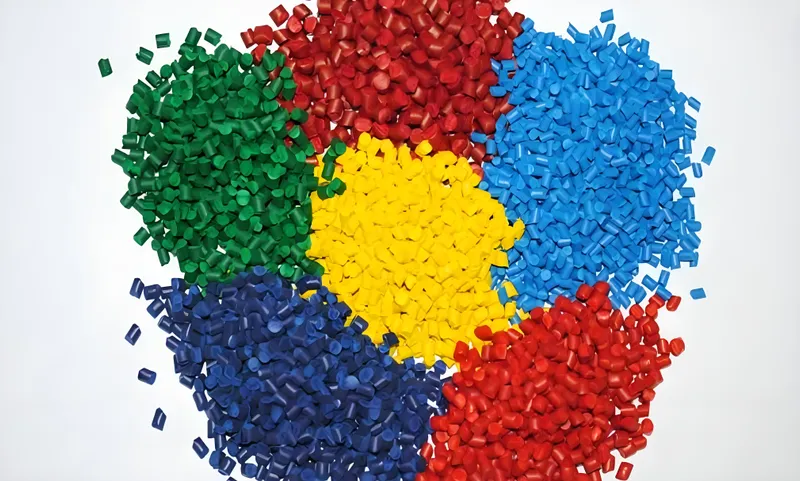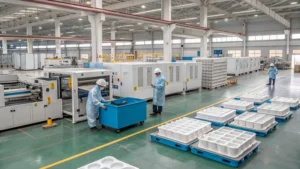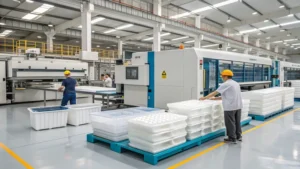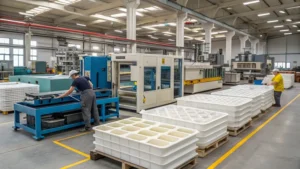
Flame-retardant plastics are essential for enhancing fire safety in industries like electronics, construction, and automotive, where extrusion processes create components requiring resistance to ignition and flame spread.
Understanding the latest advancements in flame-retardant plastics1 for extrusion can help manufacturers select the right materials for their applications, ensuring compliance with safety standards while optimizing performance. Explore further to learn about the newest materials, their applications, and key considerations for extrusion processing.
Flame-retardant plastics reduce the risk of fire in high-risk environments.True
These plastics are designed to resist ignition and slow flame spread, making them crucial for safety in industries like electronics and construction.
All flame-retardant plastics are suitable for extrusion.False
Not all flame-retardant plastics are optimized for extrusion; specific formulations are required to maintain properties during the extrusion process.
- 1. What Are Flame-Retardant Plastics and Their Importance in Extrusion?
- 2. What Are the Applications of Flame-Retardant Plastics in Extrusion?
- 3. What Are the Key Steps in the Extrusion Process for Flame-Retardant Plastics?
- 4. What Are the Three Key Factors in Extrusion of Flame-Retardant Plastics?
- 5. What Are the Differences Between Extrusion and Other Processing Methods for Flame-Retardant Plastics?
- 6. Conclusion
What Are Flame-Retardant Plastics and Their Importance in Extrusion?
Flame-retardant plastics are materials engineered to resist burning or reduce flammability, either through inherent properties or by incorporating flame-retardant additives such as phosphorus or halogen-free compounds. These plastics are vital in extrusion processes, where they are shaped into continuous profiles like sheets, pipes, or films used in high-risk applications.

Flame-retardant plastics for extrusion include Trinseo's PFAS-free polycarbonate2 and PC/ABS blends, and PA66 with LANXESS's Emerald Innovation NH 5003 additive, offering enhanced fire safety without compromising processability.
| Plastic Type | Flame-Retardant Method | Key Applications | Extrusion Parameters |
|---|---|---|---|
| Polycarbonate (Trinseo EMERGE) | PFAS-free, inherent properties | Electronics, IT equipment | Temp: 288-316°C, Screw: 25-30 L/D |
| PA66 (with Emerald Innovation) | Phosphorus-based additive | Electrical components, construction | Temp: 260-290°C, Compression: 3-4:1 |
Polycarbonate (PC)
Polycarbonate is a naturally flame-retardant plastic due to its high thermal stability. Trinseo's EMERGE PC 8600PV and 8600PR4 are PFAS-free formulations that maintain fire resistance while being environmentally friendly. These are ideal for extrusion in applications like lighting diffusers and electronic casings Trinseo Polycarbonate Resins.

Polyamide 66 (PA66)
PA665 is not inherently flame-retardant but can be enhanced with additives like LANXESS's Emerald Innovation NH 500, a phosphorus-based flame retardant. This makes PA66 suitable for extrusion in electrical components and construction materials, where fire safety is critical LANXESS Emerald Innovation.
Polycarbonate is a popular choice for extrusion due to its inherent flame-retardant properties.True
Polycarbonate's high thermal stability makes it naturally resistant to ignition, ideal for safety-critical applications.
All flame-retardant plastics are environmentally friendly.False
Some flame-retardant additives, like halogenated compounds, can pose environmental risks, but newer formulations like PFAS-free options are more sustainable.
What Are the Applications of Flame-Retardant Plastics in Extrusion?
Flame-retardant plastics are used in industries where fire safety is paramount, providing lightweight, durable solutions for various applications.
Flame-retardant plastics are extruded into components for electronics, construction, and automotive industries, offering fire resistance, design flexibility, and compliance with safety standards.

Electronics
In electronics, flame-retardant plastics like Trinseo's PC/ABS blends are extruded into casings for IT equipment, battery chargers, and voltage stabilizers. These materials prevent fire hazards in compact, high-heat environments.
Construction
For construction, PA66 with flame-retardant additives is extruded into safety components like electrical enclosures and building panels, reducing fire risks in high-risk areas.
Automotive
In the automotive sector, flame-retardant plastics are used for interior components such as dashboard panels and cable insulation, where fire resistance is critical for passenger safety.
Flame-retardant plastics reduce material costs in manufacturing.True
By offering lightweight alternatives to metals, these plastics reduce material usage and transportation costs.
Flame-retardant plastics are only used in high-temperature applications.False
While they excel in fire safety, these plastics are also chosen for their mechanical properties and design flexibility in various temperature ranges.
What Are the Key Steps in the Extrusion Process for Flame-Retardant Plastics?
The extrusion process6 for flame-retardant plastics requires precise control to maintain their fire-resistant properties while ensuring high-quality output.
The extrusion process involves material feeding, melting, shaping, cooling, and cutting, with critical parameters like temperature and screw design tailored to each plastic type.

Material Feeding
Plastic pellets, such as polycarbonate or PA66, are loaded into a hopper. For hygroscopic materials like polycarbonate, drying is essential to remove moisture that could affect extrusion quality.
Melting and Mixing
The material is heated in a single-screw extruder. For polycarbonate, temperatures range from 288-316°C, while PA66 requires 260-290°C. A three-zone screw design (25-30 L/D) ensures even melting and additive distribution.
Shaping
The molten plastic is forced through a die to form continuous profiles. Compression ratios (e.g., 2.25:1 for PC, 3-4:1 for PA66) are crucial for maintaining shape accuracy and flame-retardant properties.
Cooling and Cutting
The extruded profile is cooled using water or air and then cut to the desired length. Proper cooling is essential to stabilize the flame-retardant structure.
Precise temperature control is critical in extrusion to maintain flame-retardant properties.True
Incorrect temperatures can degrade additives or alter the polymer structure, reducing fire resistance.
All flame-retardant plastics require the same extrusion parameters.False
Each plastic type has unique processing requirements, such as temperature and screw design, to optimize performance.
What Are the Three Key Factors in Extrusion of Flame-Retardant Plastics?
Successful extrusion of flame-retardant plastics depends on several factors that influence the final product's quality and fire resistance.
The three key factors in extrusion are temperature control7, screw design, and die configuration, which directly affect the material's flame-retardant properties and processability.

Temperature Control
Maintaining the correct temperature is vital. For polycarbonate, extrusion temperatures between 288-316°C ensure proper melting without degrading the flame-retardant additives. For PA66, temperatures of 260-290°C are optimal.
Screw Design
A properly designed screw, typically with a length-to-diameter ratio of 25-30:1, ensures even mixing and distribution of flame-retardant additives, preventing inconsistencies in the final product.
Die Configuration
The die must be designed to handle the specific viscosity and flow characteristics of the flame-retardant plastic, ensuring uniform thickness and shape in the extruded profile.
Screw design affects the distribution of flame-retardant additives.True
A well-designed screw ensures even mixing, which is crucial for consistent fire resistance throughout the extruded product.
Die configuration is irrelevant in extrusion processing.False
The die directly influences the shape and quality of the extruded profile, making it a critical component in the process.
What Are the Differences Between Extrusion and Other Processing Methods for Flame-Retardant Plastics?
Extrusion offers unique advantages for producing continuous profiles of flame-retardant plastics, but it differs significantly from other methods like injection molding.
Extrusion is ideal for continuous profiles like sheets and pipes, while injection molding is better for complex, discrete parts. Extrusion offers higher efficiency for large-scale production.

Process Flow
Extrusion involves melting and continuously shaping the plastic through a die, whereas injection molding injects molten plastic into a mold to form discrete parts.
Shaping Capabilities
Extrusion is best for long, uniform profiles, while injection molding allows for intricate, three-dimensional shapes.
Production Efficiency
Extrusion is more efficient for high-volume production of continuous shapes, reducing material waste and processing time compared to injection molding.
Extrusion is more cost-effective for large-scale production.True
The continuous nature of extrusion reduces downtime and material waste, lowering overall production costs.
Injection molding cannot be used for flame-retardant plastics.False
Injection molding is commonly used for flame-retardant plastics in applications requiring complex shapes, such as electrical connectors.
Conclusion
The newest flame-retardant plastics for extrusion, such as Trinseo's PFAS-free polycarbonate and PA66 with LANXESS's Emerald Innovation NH 500, offer enhanced fire safety for industries like electronics, construction, and automotive. These materials provide lightweight, durable solutions while meeting stringent safety standards. Understanding the extrusion process and key factors like temperature control and screw design is essential for optimizing their performance.
-
Discover the latest innovations in flame-retardant plastics to enhance fire safety and compliance in various industries. ↩
-
Explore the advantages of this environmentally friendly material in electronics, focusing on fire resistance and safety. ↩
-
Learn how this specific formulation enhances fire safety in construction materials, ensuring compliance and performance. ↩
-
Discover the unique properties of Trinseo's formulations that make them environmentally friendly and fire-resistant. ↩
-
Learn how PA66 is modified for fire safety, making it crucial for construction and electrical applications. ↩
-
Understanding the extrusion process can help you appreciate the technology behind producing high-quality flame-retardant materials. ↩
-
Learn about the critical role of temperature control in ensuring the quality and safety of flame-retardant plastics during production. ↩








